#Portland protests
Text
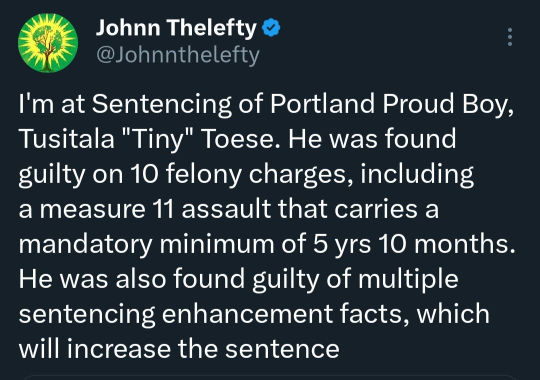
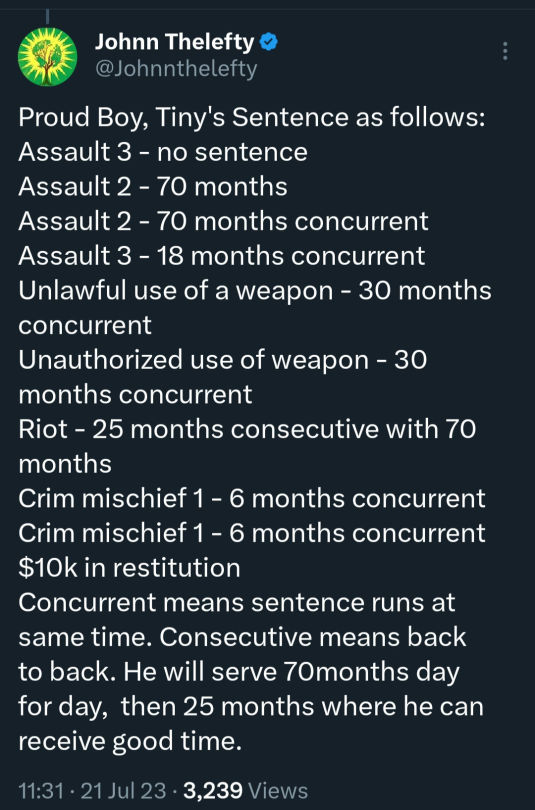
Well, it's something. Keep him off the streets for a few years.
Source
25 notes
·
View notes
Text
The Department of Homeland Security launched a failed operation that ensnared hundreds, if not thousands, of U.S. protesters in what new documents show was as a sweeping, power-hungry effort before the 2020 election to bolster President Donald Trump’s spurious claims about a “terrorist organization” he accused his Democratic rivals of supporting.
An internal investigative report, made public this month by Sen. Ron Wyden, a Democrat of Oregon, details the findings of DHS lawyers concerning a previously undisclosed effort by Trump’s acting-Secretary of Homeland Security, Chad Wolf, to amass secret dossiers on Americans in Portland attending anti-racism protests in summer 2020 sparked by the police murder of Minneapolis father George Floyd.
The report describes attempts by top officials to link protesters to an imaginary terrorist plot in an apparent effort to boost Trump’s reelection odds, raising concerns now about the ability of a sitting president to co-opt billions of dollars’ worth of domestic intelligence assets for their own political gain. DHS analysts recounted orders to generate evidence of financial ties between protesters in custody; an effort that, had they not failed, would have seemingly served to legitimize President Trump’s false claims about “Antifa,” an “organization” that even his most loyal intelligence officers failed to drum up proof ever existed.
“DID NOT FIND ANY EVIDENCE THAT ASSERTION WAS TRUE”
The DHS report offers a full accounting of the intelligence activities happening behind the scenes of officers’ protest containment; “twisted efforts,” Wyden said, of Trump administration officials promoting “baseless conspiracy theories” to manufacture of a domestic terrorist threat for the president’s “political gain.” The report describes the dossiers generated by DHS as having detailed the past whereabouts and the “friends and followers of the subjects, as well as their interests” — up to and including “First Amendment speech activity.” Intelligence analysts had internally raised concerns about the decision to accuse anyone caught in the streets by default of being an “anarchist extremist” specifically because “sufficient facts” were never found “to support such a characterization.”
One field operations analyst told interviewers that the charts were hastily “thrown together,” adding they “didn’t even know why some of the people were arrested.” In some cases, it was unclear whether the arrests were made by police or by one of the several federal agencies on the ground. The analysts were never provided arrest affidavits or paperwork, a witness told investigators, adding that they “just worked off the assumption that everyone on the list was arrested.” Lawyers who reviewed 43 of the dossiers found it “concerning,” the report says, that 13 of them stemmed from “nonviolent crimes.” These included trespassing, though it was unclear to analysts and investigators whether the cases had “any relationship to federal property,” the report says.
A footnote in the report states that “at least one witness” told investigators that dossiers had been requested on people who were “not arrested” but merely accused of threats. Another, citing emails exchanged between top intelligence officials, states dossiers were created “on persons arrested having nothing to do with homeland security or threats to officers.”
Questioned by investigators, the agency’s chief intelligence officer acknowledged fielding requests by Wolf and his acting deputy, Ken Cuccinelli, to create dossiers “against everyone participating in the Portland protest,” regardless of whether they’d been accused of any crime, the report says. That officer, Brian Murphy, then head of the agency’s Office of Intelligence and Analysis (I&A), told interviewers that he’d rejected the idea, informing his bosses that he could only “look at people who were arrested,” and adding that it was something his office had done “thousands” of times before.
The DHS report, finalized more than a year ago, includes descriptions of orders handed down to “senior leadership” instructing them to broadly apply the label “violent antifa anarchists inspired” to Portland protesters unless they had intel showing “something different.”
Once the dossiers were received by the agency’s emerging threat center, it became clear that DHS had no real way to tie the protesters to any terrorist activities, neither at home nor abroad. Efforts to drum up evidence to support the administration’s claim that a “larger network was directing or financing” the protesters — a task assigned to another unit, known as the Homeland Identities, Targeting and Exploitation Center, diverted away from its usual work of analyzing national security threats — “did not find any evidence that assertion was true,” the report says.
A TRUMPED-UP THREAT, A TRUMPED-UP HOMELAND SECURITY DEPARTMENT
Fears of political toadies occupying key intelligence roles had been aired publicly by former intelligence community members during the Trump administration’s early years, but their concerns were all but ignored by Senate Republicans during confirmation hearings that would ultimately inflict serious reputational damage on a number of agencies that, for their own survival, had long avoided partisan leanings.
The report is based on interviews with approximately 80 employees conducted by attorneys drawn from various agency components, including U.S. Customs and Border Protection and the U.S. Coast Guard. The investigation began in response to leaks of internal DHS emails in July 2020 that prompted questions from lawmakers about potential intelligence abuses, including the monitoring of journalists’ activities online and the liberal application of terrorism-related language to describe Americans engaged in protest.
I&A is one of the nation’s 17 intelligence community members overseen by the nation’s “top spy,” the Director of National Intelligence, whose office drafts daily top-secret briefings for the President. The directorship was held throughout the protests by John Ratcliffe, a Republican of Texas and renowned Trump loyalist, whose nomination to the post was withdrawn initially in 2019 over qualifications concerns raised by lawmakers and career intelligence officials.
The dossiers, known as Operational Background Reports, or OBRs, are known colloquially within the agency as “baseball cards,” the report says. The task of creating them was handed, “with little to no guidance on execution,” to the agency’s Current and Emerging Threats Center, an analysis unit whose “actionable intelligence” is distributed widely throughout the government. According to the report, the dossiers would’ve been shared with, among others, the agency’s Field Operations Division, which works closely with House and Senate committee staffers, and the Federal Protection Service, whose core mission is securing some 9,000 federal facilities across the country. The extent to which entities outside the federal government were meant to be involved is unclear; however, the report indicates that DHS state and local partners, which would naturally include law enforcement, but also potentially organizations like National Governors Association, could have also been in the loop.
Funded to the tune of $1.5 billion, the Federal Protective Service (FPS) is comprised of thousands of security officers drawn from private contractors such as Triple Canopy, a firm merged in 2014 with another contractor called Academi, previously known as Blackwater. Its staff notoriously included elite warfighters recruited from among the Navy SEALS, the Army Rangers, and the Marines expeditionary force MARSOC.
Activated to engage protesters targeting federal buildings in Portland — including the well-vandalized Hatfield Federal Courthouse — FPS personnel were eventually joined by officers hailing from across the federal government, including some on loan by the U.S. Marshals Service tactical unit normally tasked with making the arrests of the nation’s most violent fugitives. They converged for a mission dubbed “Operation Diligent Valor,” authorized under Executive Order 13933, purportedly to apprehend “anarchists and left-wing extremists” who’d been driven by Floyd’s murder to target U.S. monuments commemorating slave owners and Confederate traitors — dangerous individuals, Trump said, advancing a “fringe ideology” painting the U.S. government as “fundamentally unjust.”
Floyd’s death at the hands of Minneapolis police officer Derek Chauvin, convicted of murder and sentenced to 22 and a half years in prison in 2021, sparked more than 100 days of continuous marches in Portland. Sporadic protests continued well into the next spring, frequently marked by nightly standoffs between protesters toting bottles, fruit, and fireworks and riot-control squads armed with nightsticks, pepperspray, and “kinetic impact munitions” designed to irritate, disorient, and compel compliance through pain.
Police would eventually rack up an unprecedented 6,000 documented use-of-force cases against the demonstrators, who in turn reportedly inflicted more than $2.3 million in damage to federal buildings alone. Police ran off legal observers and physically beat journalist who suffered injuries at the hands of federal agents armed with crowd control weapons as well. In response to the bad press, Justice Department lawyers filed a successful motion in court giving police the power to force reporters off the streets.
Reports began surfacing, meanwhile, of protesters being abducted near demonstrations by men jumping out of unmarked vans in military fatigues. After widely circulated footage confirmed the accounts, DHS acknowledged the abductions, as well as the fact that agents had taken intentional steps to ensure their identities remained secret.
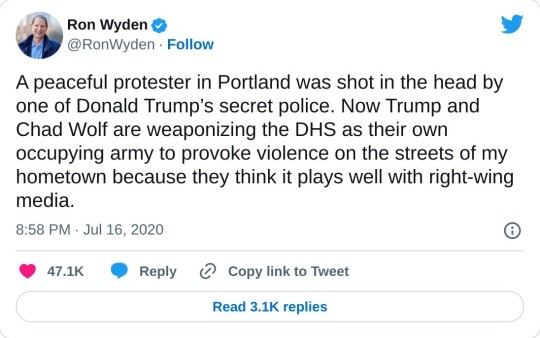
Analysts would feed protesters’ names into an array of databases, including LexisNexis, a tool used by Immigration and Customs Enforcement agents to hunt undocumented immigrants. Another tool, referred to as “Tangles” — a likely reference to the now-defunct Facebook app CrowdTangle — was used to “[compile] information from the subject’s available social media profiles.”
The report also states that dossiers were requested on multiple journalists, including Benjamin Wittes, editor-in-chief of Lawfare.
Wittes was targeted for publishing unclassified DHS materials, including the initial leak that set off the investigation. Wittes had coauthored an article at Lawfare with Steve Vladeck, a University of Texas law professor, in July 2020, which included leaked guidance — known as a “job aid” — disclosing DHS plans to act on Trump’s executive order. The document, Lawfare reported, implicated “at least parts of the intelligence community” in the “monitoring and collecting information on some protest activities.” Later leaks obtained by the New York Times included a DHS memo that, among other things, summarized tweets that had been published by Wittes.
One tweet, published on July 26 — a week after Lawfare published the guidance document — included a leaked email by DHS’s acting-Chief Intelligence Officer, relaying orders to begin referring to all violence in Portland as the work of “Antifa.”

As the summer nights grew longer and the 2020 elections near, the media spent less time focused on the cause of the demonstrations — the suffocation of a Black father of five by a white Minneapolis police officer who was outwardly unmoved by Floyd’s desperate pleas for air, or the heartrending cries for his mother. Headlines shifted instead, as if on cue, to focus on the narrative crafted by the president’s flailing reelection campaign; a pre-packed delusion designed to strike fear in voters’ imaginations and tether Democrats to a fictitious terrorist threat.
Nothing could dissuade Trump from continuing to propagate the claims, which his supporters — most to this day — continue to blindly believe. “In my book it’s virtually a part of their campaign, Antifa,” Trump said in the final months before the election. “The Democrats act like, gee, I don’t know exactly what that is.”
Trump’s highest ranking intelligence crony, John Ratcliffe, meanwhile, would go on to play the only card left with a little help from Sen. Lindsey Graham, the Republican chairman of the Senate Judiciary Committee.
Shocking and alarming career intelligence officials, Graham posted a letter online ahead of the election’s final debate. It contained a batch of Russian disinformation that a Republican-led committee had disregarded as bogus four years earlier. Apparently, it focused on the only Democrat left on whom they could find any material with which to smear: Hillary Clinton, who had no election to lose.
#us politics#news#gizmodo#donald trump#trump administration#department of homeland security#domestic terrorism#antifa#portland protests#2020 protests#2020#2022#2020 election#Sen. Ron Wyden#Chad Wolf#george floyd protests#Ken Cuccinelli#Homeland Identities Targeting and Exploitation Center#us coast guard#us customs and border protection#John Ratcliffe#Federal Protection Service#Triple Canopy#blackwater#us marshals service#Executive Order 13933#immigration and customs enforcement#Benjamin Wittes#lawfare
20 notes
·
View notes
Text
My all-time favorite experience with tourists was when I was attending a protest in Portland and this couple who were very obviously tourists (like Voodoo Donuts boxes in hand and all) came up to the crowd and watched us in awe. They looked like they were visiting the Grand Canyon. They seemed so excited to be getting the authentic Portland experience, witnessing a protest and all.
2 notes
·
View notes
Text
You really don't want to know how much was spent looking for "the antifa" when Trump was in office... but you should know anyways.
Great article from Gizmodo. Basically, a lot of time and money was spent trying to prove that "antifa" was a real thing and a real threat ... mostly to make Trump look good for his election.
The waste is bad... the human rights violations are worse. This isn't covered in the article, but there are still outstanding questions about the people snatched and put in to vans during the Portland anti-racism protests. Let's not let it all be forgotten.
4 notes
·
View notes
Text
a lot of the coverage of the Palestinian genocide is focusing on the US student protests and the narrative is constantly in danger of shifting away from what the protests are actually about and a lot of the language is now speaking in terms of police brutality, silencing of free speech, etc. It's not a radical thing to say that this isn't exactly helpful to the Palestinian cause if the actual reasons for the protests aren't constantly front and center. A lot of people have already made this point. I do not think the genie can necessarily be put back in the bottle with how the protests and the police reaction to them are entering the public consciousness of the USian people. A lot of people are or will become aware of these protests through the lense of these simply being instances of police brutality, and police brutality is a critical issue that many USamericans are very passionate about thus making it difficult to reframe the context of these images of police slamming white professors into pavement towards awareness of Israels decades long illegal occupation and systematic and indiscriminate displacement and murder of Palestinians. What I feel needs to be done is try to reframe these images flooding the internet not *away* from issues of police brutality and homesoil fascism, but in the wider context of imperialist governments taking the lessons they learn oppressing "foreign peoples" and turning them inwards. That police brutality is not disconnected from imperialist mass murder. That the one thing connecting the assaulted USian protester and the trans israeli denied gender affirming care for refusing to serve in the fascist Israeli military and the Palestinian child buried alive for the crime of being Palestinian... the one thing connecting them is that, sooner or later, they are all victims of power. Our rights are granted to us inequitably, unevenly, and are just as quickly stripped away when we do not serve the interests of fascist power. We are either a tool of the state or an enemy of the state. The Palestinian, not the innocent or the guilty but the human being Palestinian, is murdered because she can not be useful to the state while she is still breathing. She can never have the "privilege" of being a tool. I'll say it again: We outside of Palestine who can go to protests, who have families, who are able bodied, who can work, who can keep their head down or speak without immediate retaliation have the "honor" of choosing to be a tool of the state or an enemy of the state. The Palestinian has no choice.
There will always be an armed cop ready to arrest you and kill your brother as long as there is a bomb ready to drop on the heads of Palestinian children. Fascism trickles up and inward.
#palestine#protests#free palestine#end occupation#imperialism#end israeli occupation#genocide#police brutality#student protests#gaza#west bank#rafah#ucla#columbia university#chapel hill#unc#brown university#portland#university of pennsylvania#virginia tech#tulane university#university of florida#and every student movement currently gaining traction across the world
13K notes
·
View notes
Text
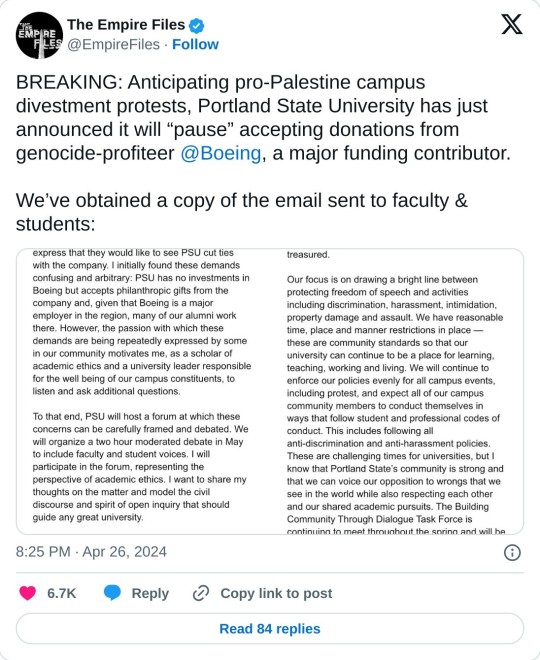


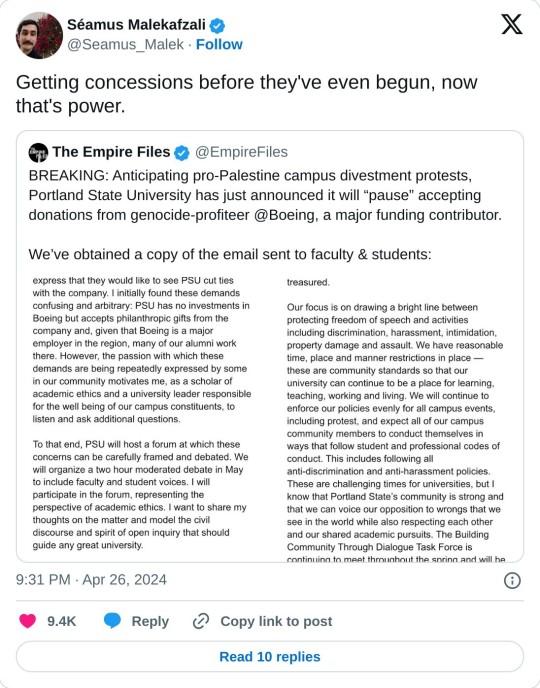
#yemen#jerusalem#tel aviv#current events#palestine#free palestine#gaza#free gaza#news on gaza#palestine news#news update#war news#war on gaza#students for justice in palestine#Portland state University#columbia university#student protests#boycott divest sanction#bds movement
2K notes
·
View notes
Text

#Wrote this in 2020#portland protests#pandemic#covidー19#poetry#poem#poet#queer poets on tumblr#blm#1312#spilled ink#queer writers#my poetey#poetic#writers on tumblr#writing#poetblr#poetscommunity#original
1 note
·
View note
Text

ONE HOUR AGO: our comrades at portland state university erected barricades around their gaza solidarity encampment after multiple face offs with the police! a couple of tweets down in this thread alissa mentions students talked about cal poly humboldt and how our comrades there inspired them. yesterday it was announced that psu would pause connections to boeing after months of students and faculty demanding the school sever ties with the company for its contributions to the genocide in palestine. our comrades are still protesting demanding complete divestment from this genocide.
#free palestine#end aid to israel#current events#palestine genocide#campus protests#let gaza live#free west bank#save palestine#bds movement#end the occupation#end the genocide#portland state university#psu#portland oregon#students for justice in palestine#gaza solidarity encampment#boycott divest sanction#from the river to the sea#free palestine in our lifetime#no one is free until we are all free#anti imperialism#the student intifada
106 notes
·
View notes
Text


I came here to post a sketch, but then saw the news.
So I dedicate this post to Netflix being slashed by Lockwood’s rapier, to Netflix being ghosted by everyone, to Netflix burning in a cold fire of the Other side.
#lockwood & co#lockwood and co#lockwood and co netflix#art#lockwood#lockwood & co netflix#lockwood art#lockwood fanart#lockwoodandco art#sketch#I’m so done that even ready to protest on the streets#while crying#good job not promoting the show at all and then cancelling it#sounds logical innit netflix#not sure how soon I’ll manage to recover from this#Portland row will forever be my home#renew lockwood and co
536 notes
·
View notes
Link
709 notes
·
View notes
Text
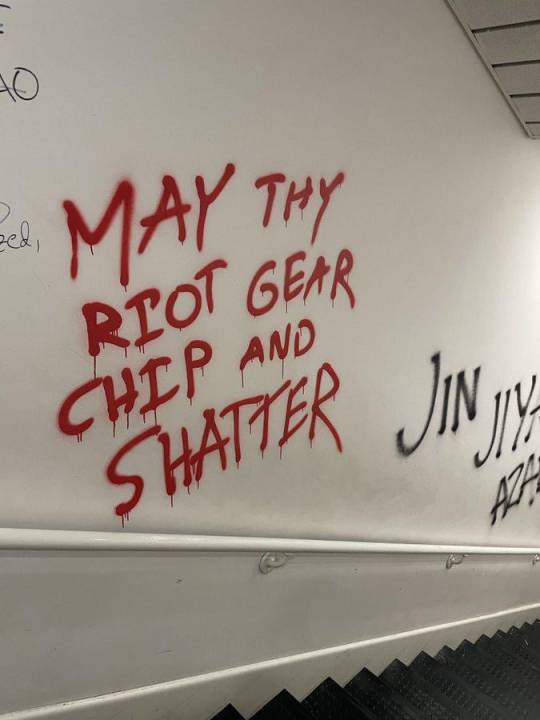
Seen inside the Portland State University encampment.
#may thy knife chip and shatter#dune memes#student protest#frank herbert's dune#campus protests#portland state university
55 notes
·
View notes
Text
This person is being sued by everyone's favorite...whatever he is...Andy Ngo.
The trial is happening *right now*.
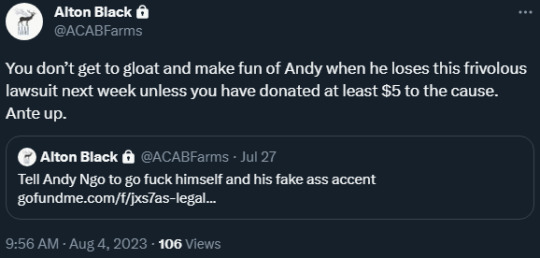
You can also use this, if you're not fond of go fund me
cas ap $ unlawfulwhatever
12 notes
·
View notes
Text
instagram
PSU students in portland oregon protesting police presence on their campus in response to the encampment in the library. PPB used rubber bullets and pepper spray. you can see them dragging a protester in a wheelchair away from the crowd.
Several protesters were arrested if you can contribute to the defense fund their venmo is defensefundPDX
60 notes
·
View notes
Text
fuck the portland police borough. i got pepper sprayed and my classmates were tear gassed. we're just students for fucks sake, there was no violence until the police showed up. i don't feel safe on campus anymore and it's not because of the protesters.
Free Palestine 🇵🇸
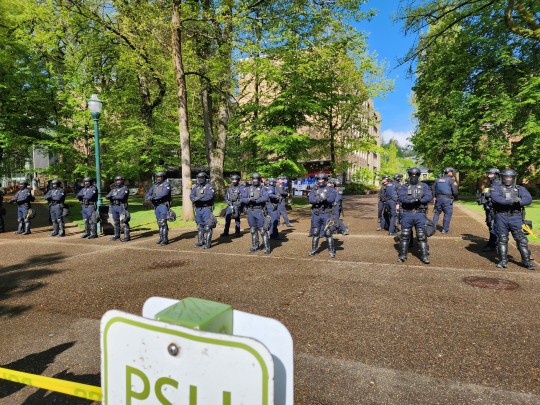
95 notes
·
View notes
Text
Portland State University’s Pro Palestine protest encampment in the library has been declared unlawful and is in imminent danger of police action. Use this script to email Ann Cudd and PSU administration to let them know you do not support the police presence on campus.




#protest#free Palestine#pro palestine#campus protests#portlandstate#Portland#portland state university#Palestine protests#Gaza#university protests#new#current events#social justice#free gaza
26 notes
·
View notes
Text


On May Day 2017, anarchists participated in lively demonstrations all around the United States, from the heartland to the coasts. In the Northwest, Seattle witnessed a successful block party at the site of a juvenile corrections center, while in Olympia anarchists barricaded train tracks to oppose fracking and clashed with police. Support arrestees here. Yet Portland, Oregon may take the cake for the most creative and combative May Day. Demonstrators not only defended themselves from unprovoked attacks from police who declared the march a riot—they also introduced exciting new innovations into the aesthetic of the black bloc street presence. Here, comrades from Portland explain their goals with the giant spiders they created for May Day, and offer a helpful guide for those who wish to make spiders of their own.
In an effort to bridge the gap between art and activism, giant spiders were assembled off-site and pushed up the street to the demonstration, stocked with water bottles, snacks, earplugs, and other party favors. The idea was to narrow the divide between “us” and “them” that often exists at demonstrations, and it was a complete success. We performed community outreach, engaged in cultural development, boosted morale, provided crucial supplies, and created an amazing photo opportunity in the process.
The concept is multi-dimensional: it works on many different levels. The idea began from frustrations around attendance at local demonstrations. In Portland, where the majority of citizens seem to be white, middle-class, and apolitical on account of these privileges, they don’t show up unless a demonstration concerns their interests specifically. However, Portlanders are fascinated by their own love of art and “wacky” stuff as well as the commodification of protest as “funtertainment.” We decided to embrace this love of the “weird” to test whether a hyper-localized approach to engaging people could succeed.
Our tactical art enabled us to fill a supporting role for other participants in the march, helping challenge narratives that the black bloc is an “othered” or “othering” tactic. Whether this separation is intentional or not, the fact remains that the general public is often hesitant to engage with us. Bearing that in mind—as well the tendency of the Portland Police Department to brutally shut down demonstrations—we stocked our Spiders with fliers, water, LAW (liquid, antacid, water, the eyewash with which street medics treat pepper spray), ear plugs, and snacks. We also included a few other party favors, because anarchy needs revelry!
We intentionally engaged with the folks around us. A lot of people walked up to ask what the spiders meant! It was inspiring to see so much dialogue between folks in everyday garb and folks in black bloc. We explained the ideas behind our actions as anarchists and the creations themselves: the three spiders representing Mutual Aid, Solidarity, and Direct Action.
A word about symbolism. The idea of using the spider as an icon of resistance is that spiders are always there watching, waiting, and keeping the environment free of pesky insects and other parasites that consume resources without supporting their fellow beings. While we may look scary, we’re here with you and for you. We are the spiders, and the insects are the societal ills that we fight against.
The symbolism of the black widow spider is rich with history that guides our work. We want to contribute to that rich history, adding our own interpretations. Mutual Aid, Solidarity, Direct Action are our black widow’s cruses. (Crux? Curse? Cures?)
In regards to developing our own culture, there are many barriers we face in this process. State repression is the biggest threat, of course. The specter of state repression can complicate organizing, planning, and building trust in our communities. Portland has a history of repression and slander, ruining the lives of activists and anarchists; these horror stories reverberate throughout the underground. We can’t allow ourselves to be publicly disparaged and forced into hiding by our adversaries and their culture war, so we create as a political act. Creating is intuitively human: we plan, we build, we think, we conspire, we imagine. It is also an activity in which everyone can engage to some degree while building new skills. It enables us to get to know each other, build trust, and share time and company.
More globally, seizing the Spectacle is a step towards our goals, because it allows us to dictate our own narratives. With the development of Public Relations and Social Engineering, the visage of capitalism has come to define its delusional reality. To paraphrase Guy Debord, lived experiences are now taken in as a collection of representational images. We can tell our own stories and show the general public what these three principles mean in action. We can create our own mythos, speaking out on our own terms, in our own language, with our own symbols. The state and media dictate too much of what we’re allowed to say and how it’s spun—it’s time to spin our own webs to connect and fortify our relationships.
We are building the bridges we need to move forward. The existing connections between art, activism, and anarchism are fiery and well-storied. The new wave of repression under Trump’s regime is still building steam, but it is already proving dangerous. We need to be more careful than ever. Art allows us to demonstrate and show our fangs, and we can use art to empower those around us.
#how-to#guides#and manuals#May Day#Portland#protest#reportback#community building#practical anarchism#anarchist society#practical#mutual aid#grassroots#organization#anarchism#resistance#autonomy#revolution#anarchy#daily posts#communism#anti capitalist#anti capitalism#late stage capitalism#grass roots#anarchists#libraries#leftism#social issues#economics
26 notes
·
View notes